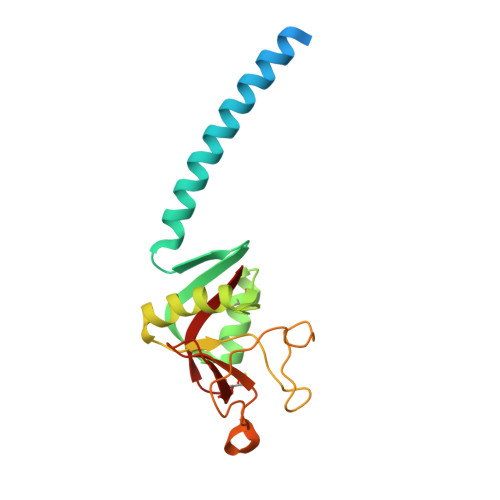Crystal Structure of a Complex of Surfactant Protein D (SP-D) and Haemophilus influenzae Lipopolysaccharide Reveals Shielding of Core Structures in SP-D-Resistant Strains.
Clark, H.W., Mackay, R.M., Deadman, M.E., Hood, D.W., Madsen, J., Moxon, E.R., Townsend, J.P., Reid, K.B., Ahmed, A., Shaw, A.J., Greenhough, T.J., Shrive, A.K.(2016) Infect Immun 84: 1585-1592
- PubMed: 26953329
- DOI: https://doi.org/10.1128/IAI.01239-15
- Primary Citation of Related Structures:
4E52 - PubMed Abstract:
The carbohydrate recognition domains (CRDs) of lung collectin surfactant protein D (SP-D) recognize sugar patterns on the surface of lung pathogens and promote phagocytosis. Using Haemophilus influenzae Eagan strains expressing well-characterized lipopolysaccharide (LPS) surface structures of various levels of complexity, we show that bacterial recognition and binding by SP-D is inversely related to LPS chain extent and complexity. The crystal structure of a biologically active recombinant trimeric SP-D CRD complexed with a delipidated Eagan 4A LPS suggests that efficient LPS recognition by SP-D requires multiple binding interactions utilizing the three major ligand-binding determinants in the SP-D binding pocket, with Ca-dependent binding of inner-core heptose accompanied by interaction of anhydro-Kdo (4,7-anhydro-3-deoxy-d-manno-oct-2-ulosonic acid) with Arg343 and Asp325. Combined with enzyme-linked immunosorbent assays (ELISAs) and fluorescence-activated cell sorter (FACS) binding analyses, our results show that extended LPS structures previously thought to be targets for collectins are important in shielding the more vulnerable sites in the LPS core, revealing a mechanism by which pathogens with complex LPS extensions efficiently evade a first-line mucosal innate immune defense. The structure also reveals for the first time the dominant form of anhydro-Kdo.
Organizational Affiliation:
University of Southampton, Department of Child Health, Division of Clinical and Experimental Sciences, Faculty of Medicine, Sir Henry Wellcome Laboratories, Southampton General Hospital, Southampton, United Kingdom.
















